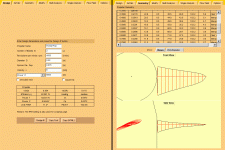Honk
100 W
- Joined
- Oct 10, 2011
- Messages
- 230
Hi all.
This thread is about the optimization of a propeller for an electric direct drive outboard at 6000W and 4500 rpm.
It originates from the Overvolting af a Minn Kota outboard thread.
http://endless-sphere.com/forums/viewtopic.php?f=39&t=38897&start=15#p594246
I felt it was time to stop parasitizing and start a new separate topic about this prop idea.
Anyway, here goes.
I tried out some more optimization in Java prop to see what it took to get heaviers blades yet keep a decent efficiency performance.
I came up with a 2-blade prop at 22cm dia with 63% efficiency. The velocity 6 m/s and 102mm pitch. Medium blade loading.
See the pic and saved Java Prop attachments.
Please have a look and I will listen to your verdicts. I'm very grateful for all inputs.
This thread is about the optimization of a propeller for an electric direct drive outboard at 6000W and 4500 rpm.
It originates from the Overvolting af a Minn Kota outboard thread.
http://endless-sphere.com/forums/viewtopic.php?f=39&t=38897&start=15#p594246
I felt it was time to stop parasitizing and start a new separate topic about this prop idea.
Anyway, here goes.
I tried out some more optimization in Java prop to see what it took to get heaviers blades yet keep a decent efficiency performance.
I came up with a 2-blade prop at 22cm dia with 63% efficiency. The velocity 6 m/s and 102mm pitch. Medium blade loading.
See the pic and saved Java Prop attachments.
Please have a look and I will listen to your verdicts. I'm very grateful for all inputs.



